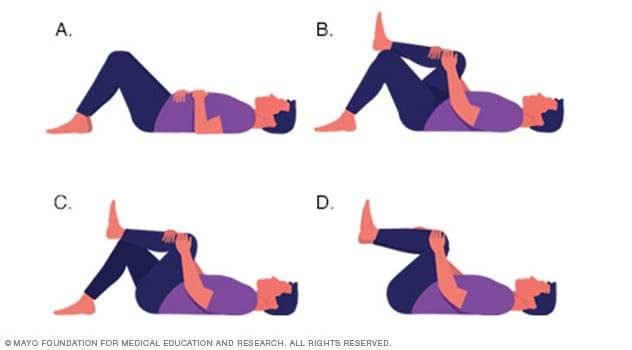Exercises for lower back pain include knee to chest, knee rotation, extensions, lower back rotation, cat/cow, child’s pose, foam rolling, and pelvic tilts. These exercises help relieve pain and promote back health.
Lower back pain is a common issue that can significantly affect daily activities and overall well-being. You can increase flexibility, reduce stiffness, and strengthen the muscles that support your spine by adding focused workouts to your program. Whether you’re dealing with acute or chronic back pain, finding the right exercises tailored to your specific needs is crucial.
Understanding the most effective and safe exercises for lower back pain can contribute to long-term relief and prevent future discomfort. With a focus on core strength and flexibility, these exercises aim to address the root cause of lower back pain while promoting overall spinal health.

Credit: physiotherapistahmedabad.com
Understanding Lower Back Pain
Relieve lower back pain with these effective exercises: knee to chest, knee rotation, extensions, lower back rotation, cat/cow, child’s pose, foam rolling, and pelvic tilts. Strengthen your core muscles, stretch daily, maintain good posture, take walks, lift correctly, reduce pressure on your back when sleeping, manage weight, and quit smoking to prevent further discomfort.
Keep moving and stay active to alleviate low back pain.
Causes Of Lower Back Pain
Numerous things might result in lower back pain, including:
- Poor posture
- Weak core muscles
- Injury or trauma
- Sedentary lifestyle
- Excessive weight
- Muscle imbalances
- Herniated or bulging discs
It’s important to identify the underlying cause of your lower back pain in order to effectively address it through targeted exercises and treatments.
Impact Of Lower Back Pain On Daily Life
Lower back pain can have a significant impact on your daily life and functioning. Here are a few potential effects on you:
- Interference with daily activities and tasks
- Decreased mobility and flexibility
- Difficulty sitting, standing, or walking for extended periods
- Impaired sleep quality
- Increased stress and decreased overall well-being
- Limitations in participating in physical activities
Understanding how lower back pain can impact your daily life can motivate you to take proactive steps to manage and alleviate the pain through exercises and other treatment options.

Credit: www.arthritis-health.com
Exercises To Relieve Lower Back Pain
Lower back pain can be debilitating, but incorporating specific exercises into your routine can help alleviate discomfort and strengthen your back muscles. Here are some effective exercises to relieve lower back pain:
Strengthening Core Muscles
- Plank exercises
- Crunches
- Sit-ups
Daily Stretching Routine
- Hamstring stretches
- Cat/Cow poses
- Knee-to-chest stretches
Movement And Physical Activities
- Walking
- Swimming
- Cycling
Best And Worst Exercises For Lower Back Pain
For those dealing with lower back pain, knowing the best and worst exercises can make a significant difference in managing discomfort and promoting healing.
Recommended Exercises
- Knee-to-Chest Stretch: Gentle pull knees to chest, hold, and extend arms.
- Lower Back Rotations: Perform gentle rotations to release tension.
- Pelvic Tilts: Engage core muscles to tilt the pelvis for stability.
- Bridge Exercise: Strengthen lower back and core muscles.
Exercises To Avoid
- Avoid Toe Touches: Straining the lower back by bending forward.
- Avoid Heavy Weightlifting: Putting excessive pressure on the spine.
- Avoid High-Impact Activities: Such as running or jumping, that jolt the back.
Professional Advice And Insights
Understanding professional insights and advice on lower back pain relief can be crucial in managing discomfort effectively.
Physiotherapy Exercises For Lower Back Pain
Physiotherapy exercises play a significant role in alleviating lower back pain by targeting key muscle groups.
Consider incorporating these recommended exercises:
- Bridge Exercise: Engages your core and glutes for stability.
- Knee to Chest Stretch: Relieves tension in the lower back and hips.
- Pelvic Tilts: Improve spinal alignment and strengthen core muscles.
Consulting with a physiotherapist can provide personalized guidance on the most effective exercises for your specific condition.
Benefits Of Regular Exercise For Lower Back Pain
Regular exercise offers various benefits for individuals experiencing lower back pain. By incorporating specific exercises into your daily routine, you can manage discomfort and improve overall spinal health, mobility, and flexibility.
Improving Flexibility And Mobility
Engaging in regular exercise routines, such as yoga or Pilates, can improve your lower back’s flexibility and mobility. These exercises stretch and strengthen the muscles supporting the spine, reducing the risk of stiffness and discomfort.
Aiding Weight Management
Maintaining a healthy weight is crucial for lower back pain management. Regular exercise aids in weight management by burning calories, reducing excess pressure on the lower back, and promoting overall well-being.
Promoting Better Posture And Spinal Health
Exercise plays a vital role in promoting better posture and spinal health by strengthening the core muscles that support the spine. It also helps in preventing poor posture-related discomfort and reduces the risk of future lower back pain episodes.

Credit: medium.com
Integrating Exercise Into Daily Life
Suffering from lower back pain can be debilitating, but integrating simple exercises into your daily routine can help alleviate discomfort and strengthen the muscles that support your spine. By incorporating targeted exercises and adopting back-friendly habits, individuals can effectively manage and prevent lower back pain. These exercises don’t require expensive equipment or extensive time commitments, making them accessible for individuals with busy schedules.
Exercise Tips For Office Workers
For office workers, practicing regular stretching and corrective postures are crucial in combating the effects of prolonged sitting. Engage in simple stretches and ergonomically improve your workspace to reduce strain on your lower back.
- Perform neck and shoulder rolls every hour to release tension.
- Use a standing desk for intervals throughout the day to reduce prolonged sitting.
- Practice deep breathing exercises to relax and elongate the spine.
Creating A Back-friendly Workout Routine
Establishing a workout routine focused on strengthening the core and back muscles is essential for preventing and managing lower back pain. Incorporate these exercises into your routine:
- Try Yoga or Pilates to improve flexibility and strengthen core muscles.
- Engage in low-impact cardiovascular activities such as swimming or walking to enhance overall fitness without straining the lower back.
- Focus on plank exercises to build core strength and stabilize the lower back.
Holistic Approaches To Alleviate Lower Back Pain
Holistic approaches to alleviating lower back pain focus on exercises that strengthen the core muscles and improve flexibility, such as knee-to-chest stretches, pelvic tilts, and hamstring stretches. These exercises help reduce pain and prevent future episodes by promoting proper body alignment and muscle support.
Combining Exercise With Lifestyle Changes
When it comes to alleviating lower back pain, taking a holistic approach that combines exercise with lifestyle changes can be highly effective. By incorporating regular physical activity and making small adjustments to your daily routine, you can not only reduce pain but also prevent future episodes of back discomfort.
Alternative Therapies And Complementary Practices
In addition to exercise and lifestyle changes, alternative therapies and complementary practices can also play a crucial role in managing lower back pain. These practices can help alleviate pain, improve flexibility, and promote overall well-being. Some of the most effective alternative therapies and complementary practices for lower back pain include:
- Acupuncture: A traditional Chinese therapy that involves the insertion of thin needles into specific points on the body to stimulate healing and pain relief.
- Chiropractic Care: A hands-on approach to spinal manipulation and adjustment that can improve joint mobility and alleviate lower back pain.
- Yoga and Pilates: These mind-body practices focus on strengthening and stretching the muscles, improving posture, and increasing flexibility.
- Massage Therapy: By targeting the muscles and soft tissues, massage therapy can reduce tension and promote relaxation, leading to pain relief.
- Heat and Cold Therapy: Applying heat or cold to the affected area can help reduce inflammation, relieve muscle spasms, and alleviate lower back pain.
By incorporating these holistic approaches into your pain management plan, you can experience long-term relief from lower back pain and improve your overall quality of life. Remember to consult with a medical professional before starting any new exercise program or alternative therapy to ensure it is safe and suitable for your individual condition.
Customizing Exercises For Specific Needs
Customizing exercises for specific needs can be incredibly beneficial when it comes to targeting and relieving lower back pain. By incorporating exercises such as knee to chest stretches, pelvic tilts, and core strengthening, individuals can find significant relief and improve their overall back health.
Exercises For Seniors
For seniors, low-impact exercises are crucial to managing back pain. Simple activities like walking, yoga, and water aerobics can help maintain flexibility and strength.
Low-impact And Safe Exercise Options
Low-impact exercises such as swimming and cycling are gentle on the back yet effective for relieving pain. Use the right form and technique to avoid getting hurt.
Frequently Asked Questions Of Exercises For Lower Back Pain
What Is The Best Exercise To Relieve Lower Back Pain?
The best exercise to relieve lower back pain is the Knee-chest stretch. Simply lay on your back and gently pull your knees towards your chest, then extend your arms straight out.
How Do You Get Rid Of Lower Back Pain?
Strengthen your core muscles and stretch daily to ease lower back pain. Maintain good posture, take walks, lift correctly, and manage weight.
Does Walking Help Lower Back Pain?
Walking can help lower back pain.
What Not To Do With Lower Back Pain?
To avoid exacerbating lower back pain, refrain from: 1. Lifting heavy objects 2. Sitting for prolonged periods 3. Performing high-impact exercises 4. Slouching or poor posture 5. Ignoring discomfort (seek medical advice)
Conclusion
To effectively alleviate lower back pain, incorporating specific exercises into your routine is essential. Knee-to-chest, knee rotation, extensions, lower back rotation, cat/cow, child’s pose, foam rolling, and pelvic tilts are all exercises that target and relieve discomfort in the lower back.
Additionally, it is crucial to strengthen your core muscles, maintain good posture, stretch daily, and engage in regular physical activity. By adopting these practices and avoiding high-impact movements, you can significantly improve your lower back health and reduce pain. Take control of your well-being and embrace exercises that prioritize your lower back’s strength and flexibility.

I am a health writer and blogger based in the US and UK. I have been with the health department for six years. And I give advice on various health problems and solutions. I have a lot of experience in health matters and I share it here.

